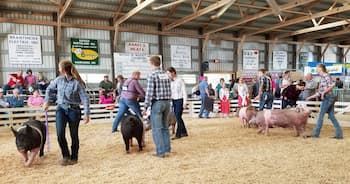Formula For Show Pig Success Includes Starting Slow
Dec 17, 2019

Show pig success is dependent on a variety of factors, from daily care to presentation, to quality of project and beyond.
Perhaps one of the most challenging factors is nutrition - feeding the project animal through to show day. And, it’s not an easy task when the desired look for pigs is changing. Judges are starting to look for pigs that are both fresh and fat enough, but also have shape, are not overly full, and are tall and clean-fronted.
This transition is shifting how we as exhibitors think about nutrition. Historically, the focus has been on meeting certain weights and feeding a certain product once that weight is achieved, but I encourage people to think about show pig nutrition another way – soundness and fat cover.
Instead of the old thought process of – ‘when they’re 25 pounds, feed this, and when they’re 100 pounds, feed that’ – really focus your strategy on feeding for soundness and fat cover.
Using nutrition to impact soundness
Lessons learned in the steer ring can be applied to show pigs.
For example, steers almost two years old are winning shows because they’ve been bred to be so extreme. By growing these cattle slow, it can be possible to manipulate structure. This same philosophy can be applied to pigs.
Similar to steers wanting to bow their legs, getting a little straight in their leg or not quite hitting their stride – the same can be impacted on the pig side.
By managing diets, we can attempt to control how an animal walks. Then, once they get to a certain size, you can mass them up, and they’ll still walk soundly; but, the key is to go slow and steady on nutrition.
Feeding for fat cover
Shoot for pigs to be 150 pounds, or pretty close at 60 days out from the show. Then aim for them to be about 200 pounds at 30 days out. From there, every decision made is related to soundness, fat cover or both.
For an average to good muscled pig, start with a bag of 20% protein feed, then transition to an 18% protein feed. For a heavy muscled or harder made pig, a 20% protein feed transitioning to a 16% protein feed.
A variety of show supplements exist to further modify appearance. For more fat cover, high fat supplements can be added to the diet. For additional shape and expression of muscle, supplements with extra protein can be added, and for extra body and fill a high fiber supplement can be added.
The biggest mistake I see people make is feeding too high of protein and too much feed early on. Pigs can get too massed up early in life and end up with structural problems. Start slow, don’t feed too hard, too early and keep an eye on the protein level.
----Purina Animal Nutrition
Perhaps one of the most challenging factors is nutrition - feeding the project animal through to show day. And, it’s not an easy task when the desired look for pigs is changing. Judges are starting to look for pigs that are both fresh and fat enough, but also have shape, are not overly full, and are tall and clean-fronted.
This transition is shifting how we as exhibitors think about nutrition. Historically, the focus has been on meeting certain weights and feeding a certain product once that weight is achieved, but I encourage people to think about show pig nutrition another way – soundness and fat cover.
Instead of the old thought process of – ‘when they’re 25 pounds, feed this, and when they’re 100 pounds, feed that’ – really focus your strategy on feeding for soundness and fat cover.
Using nutrition to impact soundness
Lessons learned in the steer ring can be applied to show pigs.
For example, steers almost two years old are winning shows because they’ve been bred to be so extreme. By growing these cattle slow, it can be possible to manipulate structure. This same philosophy can be applied to pigs.
Similar to steers wanting to bow their legs, getting a little straight in their leg or not quite hitting their stride – the same can be impacted on the pig side.
By managing diets, we can attempt to control how an animal walks. Then, once they get to a certain size, you can mass them up, and they’ll still walk soundly; but, the key is to go slow and steady on nutrition.
Feeding for fat cover
Shoot for pigs to be 150 pounds, or pretty close at 60 days out from the show. Then aim for them to be about 200 pounds at 30 days out. From there, every decision made is related to soundness, fat cover or both.
For an average to good muscled pig, start with a bag of 20% protein feed, then transition to an 18% protein feed. For a heavy muscled or harder made pig, a 20% protein feed transitioning to a 16% protein feed.
A variety of show supplements exist to further modify appearance. For more fat cover, high fat supplements can be added to the diet. For additional shape and expression of muscle, supplements with extra protein can be added, and for extra body and fill a high fiber supplement can be added.
The biggest mistake I see people make is feeding too high of protein and too much feed early on. Pigs can get too massed up early in life and end up with structural problems. Start slow, don’t feed too hard, too early and keep an eye on the protein level.
----Purina Animal Nutrition